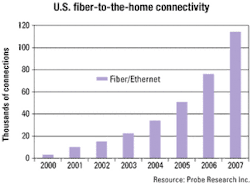Pushing fiber to user: Reality check
The once-enthusiastic certainty that fiber-optic technology would soon force its way into businesses across the country—capturing the premises market and ousting copper once and for all—seems to be on the same track as the promise of OC-768 (40-Gbit/sec) optical-backbone networks. In other words, we have the technology, but does anybody really need it today?
Most optical-backbone networks are operating just fine at OC-48 (2.5 Gbits/sec) or OC-192 (10 Gbits/sec). Similarly, at the other end of the network—the enterprise or premises—the acceptance of fiber as today's "architecture of choice" continues to meet stiff resistance. With a few exceptions, getting fiber connectivity directly into offices, not to mention homes, will require much more than simply having the technology to do it.
Despite the decline in optical optimism, work is progressing toward educating network architects that running fiber through their risers will ultimately prove a smart decision. With predictions that the need for high-bandwidth applications will continue to rise and the price disparity between fiber and copper will slowly diminish, fiber should continue to erode copper's grip on the premises market—though much more subtly than the advent of Gigabit Ethernet (GbE) might initially have presaged.
In this context, many view fiber-to-the-business or -home as a necessity before we see much fiber in the business or home. Telecommunications analyst Probe Research (Cedar Knolls, NJ) projects that consumer and small-office/home-office (SOHO) fiber/Ethernet connectivity will grow from an estimated 15,000 connections at the end of 2002 to 113,900 connections by year end 2007, a compound annual growth rate of 50% (see Figure)."The RBOCs are only showing casual interest at this point," says Alan Mosher, a research director at Probe. "Their interest may grow if the FCC rules that they would not have to unbundle any investment they might make in fiber infrastructure. It appears that the FCC may very well rule in the RBOCs' favor in the near future."
Still, says Mosher, there is no indication that the RBOCs will rush out and begin overbuilding their copper networks with fiber. Instead, he believes there will be some integration of fiber as new residential neighborhoods are developed.
Thus, it may be left to others besides the RBOCs to push fiber closer to customers in significant numbers. The FTTH Council (Washington, DC) has touted a recent study by Render, Vanderslice & Associates (Tulsa, OK) that predicts 315,000 homes in the United States and Canada will be passed by fiber-to-the-home (FTTH) networks this year, a figure the study predicts will rise to one million next year (see Lightwave, December 2002, page 19). According to that study, and in the opinion of other analysts, independent carriers and others will carry the fiber standard.
"Just about all the projects are and will be subsidized and most will be through independents and municipally owned carriers," says David Gross, research director for optical networking at Communications Industry Researchers (CIR—Charlottesville, VA). "These rural telcos will continue to be the primary niche for FTTH, with the RBOCs and MSOs [multiservice operators] doing virtually nothing beyond a few showcase projects."
Eventually, as the cost to deploy new networks with fiber becomes competitive with the cost of copper, fiber would be the choice for both home and business users. For the foreseeable future, however, optical access technologies are a long way from any large deployment numbers, and copper will still be king in the United States for several years. Needless to say, while that doesn't bode well for fiber within business LANs, the prognosis for fiber within home networks is even darker. The fact is that in-home fiber connections are much farther away than imagined just two years ago—so far away that analysts contacted for this article wouldn't offer a prediction on the timeline.
Still, pockets of interest in using fiber to improve business networks have developed around the United States. Air-blown fiber, or blowing fiber through conduits placed within a building, gained a decent following in European enterprise networks and is generating some momentum in North America (see Lightwave, April 2002, page 1).
In addition, distributed active media zone installations, also known as "fiber-in-the-zone," are a more recent use of fiber in the horizontal. In this architecture, fiber cable is deployed from the equipment room through a passive telecommunications room to a horizontal zone location, such as a ceiling, that houses an electronic switch or hub. Short lengths of copper cable are dropped from the electronics to the wall outlet and directly to each desktop. In a four-floor building with 96 users per floor, one GbE fiber uplink can be used to provide a 100-Mbit/sec connection to each desktop. Therefore, what was once an all-copper infrastructure becomes a fiber/ copper hybrid that provides greater capacity for less cost.
Certainly, these and other technologies are targeting the end user's appetite for more capacity and speed, but there are other catalysts that may eventually enable fiber to dominate the premises market. Data bandwidth, as a necessary function of business, continues to become more resilient to economic turmoil.
"The combination of new opportunities, a paradigm shift to data-dominated networks, and continued growing demand for bandwidth are contributing to a resurgence in the access network," says Matt Squire, chief technical officer at Hatteras Networks (Research Triangle Park, NC). "This resurgence in the access, in some cases, will provide some catalyst for replacing copper with fiber [in premises networks]."
The reduced cost for optical resources, higher-bandwidth applications, new standards for fiber in the premises, and an overall awareness of fiber benefits and scalability is beginning to capture the interest of enterprise-network architects. Even collaboration with wireless technology may indirectly boost fiber's presence in the enterprise.
"Ironically, one big catalyst [for fiber in the premises] may be the growing adoption of wireless fidelity (Wi-Fi) wireless LAN technologies," says Charles Gerlach, communications sector executive for IBM's Institute for Business Value. "This technology demands a network architecture that can take advantage of fiber's strengths such as high bandwidth, long cable runs, and centralized architecture, while largely eliminating one of the biggest costs—special and expensive network interface cards for the PCs and devices using the network."
According to CIR's Gross, an increasing interest in both SANs and LAN extension has led to a limited number of corporations building their own fiber networks to connect offices. "Storage applications for both mainframes and UNIX servers have been important for persuading banks and brokerages to bring fiber into their buildings," says Gross. "The reason that industry is ahead of others is the requirement that remote data be accessible in one second or less. Transaction time has proven to be a more important consideration for adding optically connected storage facilities than data volume."
Despite these positive signs, the Fiber Optic LAN Section (FOLS) of the Telecommunications Industry Association (TIA—Arlington, VA), an organization dedicated to the awareness of optical technologies for customer-owned networks, concedes that the United States is still a long way from realizing mass adoption of fiber in the home and office. The existing copper/coaxial infrastructures and competitive nature of U.S. companies—offering various flavors of cable television, video on demand, videoconferencing, local and long-distance telephone, and dial-up and broadband Internet services—make convergence of multiple technologies and services over a single high-bandwidth optical connection to the desktop or the living room somewhat complicated.
But FOLS is still actively promoting the fiber cause. The group points to very active initiatives overseas that will bring the benefits of fiber to home and business subscribers, primarily in multitenant office buildings and apartment complexes. Service providers in Italy, Japan, and Sweden are pioneers in this area. It is only a matter of time before network managers in the United States catch on, FOLS spokespeople believe.
"Awareness of network-lifecycle costs work in favor of fiber," says John Struhar, chairman of FOLS and fiber-optic application engineer at OFS (Norcross, GA). "Total cost of ownership has been applied to software and computers—and now IT managers are starting to take this into consideration for their cabling infrastructure. Looked at over the life of the network, fiber offers users tremendous savings by lowering maintenance costs, improving reliability, reducing network downtime, and allowing Ethernet-speed upgrades using the same cable, rather than by pulling new cable."
Still, there are a number of unanswerable questions. Will networking applications ever necessitate the use of fiber in most businesses? Will legacy copper and coaxial architectures continue to adapt to meet current demand for bandwidth? And finally, will the inherent costs associated with optical networking, particularly initial installation costs and the costs of the associated "electronics," decrease enough to make fiber the dominant choice in the premises network?
"The last-mile problem in the optical network has a solution," says CIR's Gross. "Patience." That solution appears equally apt for proponents of fiber in premises networks.


